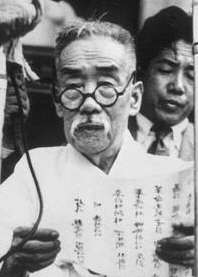Yi Si-yeong
For other people with the same name, see Lee Si-yeong (disambiguation).
| Yi Si-yeong | |
|---|---|
 | |
| Vice President of South Korea | |
|
In office 24 July 1948 – 9 May 1951 | |
| President | Syngman Rhee |
| Succeeded by | Kim Seong-su |
| Personal details | |
| Born |
3 December 1868 Hanseong-bu, Joseon |
| Died |
April 19, 1953 (aged 84) Busan, South Korea |
| Political party | Democratic Party |
| Religion | Confucianism |
| Yi Si-yeong | |
| Hangul | 이시영 |
|---|---|
| Hanja | 李始榮 |
| Revised Romanization | I Siyeong |
| McCune–Reischauer | Ri Siyŏng |
| Pen name | |
| Hangul | 성재 |
| Hanja | 省齋 |
| Revised Romanization | Seongjae |
| McCune–Reischauer | Sŏngjae |
| Courtesy name | |
| Hangul | 성흡 |
| Hanja | 聖翕 |
| Revised Romanization | Seongheup |
| McCune–Reischauer | Sŏnghŭp |
| Pen name | |
| Hangul | 시림산인 |
| Hanja | 始林山人 |
| Revised Romanization | Sirimsanin |
| McCune–Reischauer | Sirimsanin |
Seongjae Yi Si-yeong (Korean: 이시영; hanja: 李始榮, December 3, 1868 – April 19, 1953) was a Korean politician, independence activist, educator and Neo-confucianism scholar. He was the first Vice President of South Korea from 1948 to 1951.[1] Yi resigned after the National Defense Force Incident. His nickname was Seongjae (성재; 省齋), Sirimsanin (시림산인; 始林山人). Before, the Japan–Korea Treaty of 1910, he had served for Joseon, as the Governor of South Pyongan Province and the President of Hansung Law Court.
Work book
- Gamseemanuh (감시만어, 感時漫語)
See also
References
- ↑ Hanguksa daesajeon (한국사대사전 Encyclopedia of Korean history) (2004), Goryeo chulpansa (고려출판사), p.1039
Site Link
- Yi Si-yeong (Korean)
- Yi Si-yeong:Navercast (Korean)
- Yi See-young:Korean historical persons information (Korean)
- Yi See-young (Korean)
- Yi See-young (Korean)
- Yi See-young:Nate (Korean)
| Political offices | ||
|---|---|---|
| Preceded by |
Governor of South Pyongan Province 1906–1907 |
Succeeded by |
| Political offices | ||
|---|---|---|
| Preceded by Office created |
Vice President of South Korea 1948–1951 |
Succeeded by Kim Seong-su |
This article is issued from Wikipedia - version of the 3/12/2016. The text is available under the Creative Commons Attribution/Share Alike but additional terms may apply for the media files.